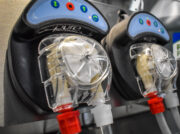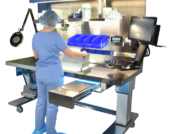
Identifying Educational Needs for Your Department
In August, we brought our Voice of the Customer panel together to delve into a topic that SPD professionals across country identified as top-of-mind in our 2023 SPD State of the Industry Report: training & education.
With standards & guidelines continuing to evolve and the complexity of instruments growing, keeping a team’s knowledge and skills relevant is a perpetual challenge. Before training & education needs can be addressed in a department, they must be identified.
We collaborated with Beth Rayfield, Director of SPD at IU Health, to further explore what our Voice of the Customer panel had to say about training & education.
Signs that training & education are needed
Sometimes deficiencies can be tough to spot. The quickest way to get an objective assessment of potential gaps in skills and knowledge on a team is to look at data and trends. A few examples our VOC provided included:
- An increase or abnormally high instances of breakage: If certain instruments or scopes suddenly see an uptick in damage or breakage, there’s a chance that training hasn’t been sufficient, or that bad habits have taken root.
- Errors: Analyzing the number of errors occurring and the devices they’re occurring with can illuminate areas of opportunity for training & education. While errors being caught in prep & pack are a good way to identify potential shortcomings in decontamination, listening to the OR about errors they’re seeing offers a 360-degree view into error rates.
- Testing: Observing your department and testing instruments at various phases of reprocessing can offer a window into the needs of your department on a more granular level.
Conduct onboarding assessments
One of the best opportunities to identify whether training and education is necessary is during onboarding. Rayfield explained that in her department everyone, whether brand new to the industry or highly experienced, is given an assessment during onboarding.
Onboarding assessments provide a manager or educator with the opportunity to spot gaps in a new worker’s knowledge at the onset and incorporate resources to fill those gaps during their initial 8–12-week training period.
Involve the whole team
Training and education doesn’t start or end with a manager; it’s something that the whole team should be invested in, which means everyone should have the opportunity to be heard regarding training & education needs. Rayfield offered a couple ways to do so:
- Listen to your educator: Educators have a honed eye for identifying training and education needs and putting the plan together to address them. Ignoring an educator’s advice severely restricts your department’s ability to improve.
- Listen to your technicians: Technicians know what they need, so if they come to you asking for specific training, education, or elaboration on a certain aspect of their work, find a way to make it happen. The same need may be shared amongst others, too.
- Create a collaborative environment: It’s tough to listen to your team if they don’t feel comfortable making their voice heard. To help create that comfort, be sure to voice your openness to hearing suggestions and fielding requests for additional training. Sterile processing is a profession that requires considerable skill and knowledge to do it effectively, and nobody is perfect. Your team should know that it’s okay to say, “I’m not sure how do this,” and know that they’ll be given the resources to improve themselves when they do.
- Give opportunities to voice needs: Even in an environment where speaking up is encouraged, if there isn’t a good time, place, or means to say something, it won’t get said. Rayfield explained that conducting a team huddle at the beginning of every shift offers the opportunity to highlight necessary information about tricky instruments that are likely to be coming through and open the floor for the team to voice potential training needs.
A good test: understanding the ‘why’
Finally, an effective way to proactively identify areas of opportunity regarding training & education in a department is asking your team to explain the ‘why’ behind specific tasks and activities.
It’s easy to tell a teammate that something needs to be done a certain way, but if they don’t understand the reasoning behind it, there’s a good chance that steps are being missed. In the event a technician is unable to provide the ‘why’ behind an activity or step within an IFU, it should be noted and followed up on with other members of the team.
Conclusion
Training & education is a vital component of keeping a sterile processing department effective, and patients safe. While there are various ways to identify whether additional training & education is required in your department, there are few key things to keep in mind:
- Look at the data: Oftentimes, insufficient training will manifest itself if quantifiable ways, such as error or breakage rates.
- Observe your department: Walk the floor and observe your team at work.
- Communicate: Keep all lines of communication open. Be available to answer questions and listen to what your team has to say.
Looking for additional insights on training & education? Check out all our Reprocessing Reports on training & education!
Interested in diving into what SPD professional across the United States and Canada are seeing in 2023? Download our 2023 SPD State of the Industry Report!
About: Voice of the Customer Committee
The Voice of the Customer Committee is a panel of healthcare and instrument reprocessing professionals who have graciously donated their time to share their expertise and guidance on current challenges faced by the instrument reprocessing community. Through sharing their insights, experiences, and best practices, we have been given the opportunity to share these findings with our readership. We’d like to thank our VOC members for their outstanding input and insights, as well as their time! Thank you for your continued partnership, and all you do.






